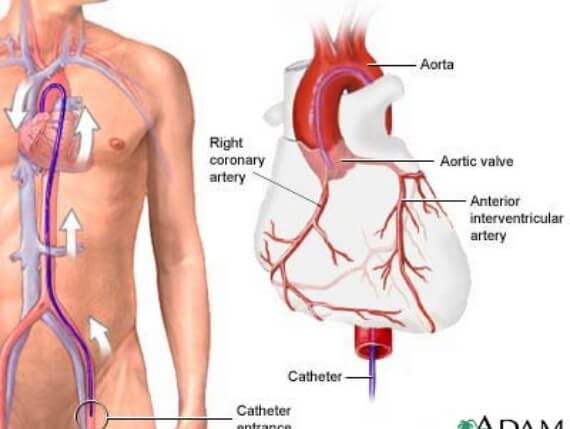Coronary Angiography
What is a Coronary Angiography?
A coronary angiography is a test to find out if you have a blockage in a coronary artery. Your doctor will be concerned that you’re at risk of a heart attack if you have unstable angina, atypical chest pain, aortic stenosis, or unexplained heart failure.
During the coronary angiography, a contrast dye will be injected into your arteries through a catheter (thin, plastic tube), while your doctor watches how blood flows through your heart on an X-ray screen.
This test is also known as a cardiac angiogram, catheter arteriography, or cardiac catheterization.


Preparing for a Coronary Angiography
Don’t eat or drink anything for eight hours before the angiography. Arrange for someone to give you a ride home. You should also have someone stay with you the night after your test because you may feel dizzy or light-headed for the first 24 hours after the cardiac angiography.
In many cases, you’ll be asked to check into the hospital the morning of the test, and you’ll be able to check out later the same day.
At the hospital, you’ll be asked to wear a hospital gown and to sign consent forms. The nurses will take your blood pressure, start an intravenous line and, if you have diabetes, check your blood sugar. You may also have to undergo a blood test and an electrocardiogram.
Let your doctor know if you’re allergic to seafood, if you’ve had a bad reaction to contrast dye in the past, if you’re taking sildenafil (Viagra), or if you might be pregnant.
Coronary Angiography FAQs
Before the test, you’ll be given a mild sedative to help you relax. You’ll be awake throughout the test.
Your doctor will clean and numb an area of your body in the groin or arm with an anesthetic. You may feel a dull pressure as a sheath is inserted into an artery. A thin tube called a catheter will be guided gently up to an artery in your heart. Your doctor will supervise the whole process on a screen.
It’s unlikely that you’ll feel the tube move through your blood vessels.
A slight burning or “flushing” sensation can be felt after the dye is injected.
After the test, pressure will be applied at the site where the catheter is removed to prevent bleeding. If the catheter is placed in your groin, you may be asked to lie flat on your back for a few hours after the test to prevent bleeding. This can cause mild back discomfort.
Drink plenty of water after the test to help your kidneys flush out the contrast dye.
We believe in health equity—the equal opportunity for everyone to live their healthiest life. We are clarifying health inequities and creating a healthier world—for everyone.
Understanding the results of a coronary angiography
The results show whether there is a normal supply of blood to your heart and any blockages. An abnormal result may mean that you have one or more blocked arteries. If you have a blocked artery, your doctor may choose to do an angioplasty during the angiography and possibly insert an intracoronary stent to immediately improve blood flow.
To help you take good care of your heart, we’ll send you guidance on managing high blood pressure, cholesterol, nutrition, and more.
Risks associated with getting a coronary angiography
Cardiac catheterization is very safe when performed by an experienced team, but there are risks. Risks can include:
- bleeding or bruising
- blood clots
- injury to the artery or vein
- a small risk of stroke
- a very small chance of a heart attack or a need for bypass surgery
- low blood pressure
Recovery and follow-up when you get home
- Relax and drink plenty of water. Don’t smoke or drink alcohol.
Because you’ve had an anesthetic, you shouldn’t drive, operate machinery, or make any important decisions immediately. - Remove the bandage after 24 hours. If there’s minor oozing, apply a fresh bandage for another 12 hours.
- For two days, don’t have sex or perform any heavy exercise.
- Don’t take a bath, use a hot tub, or use a pool for at least three days. You may shower.
- Don’t apply lotion near the puncture site for three days.
- You’ll need to see your heart doctor a week after the test.
